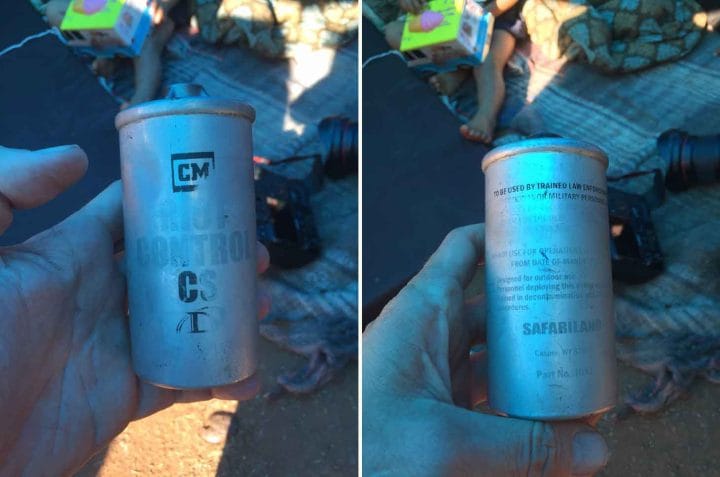Whitney Museum Staffers Demand Answers After Vice Chair’s Relationship to Tear Gas Manufacturer Is Revealed
Three days after Hyperallergic published an article detailing the Whitney Museum's connection to the ongoing migrant crisis at the US-Mexico border, more than 100 staffers at the Manhattan-based museum have signed a letter demanding that their employers respond to the article's allegations.

Three days after Hyperallergic published an article detailing the Whitney Museum’s connection to the ongoing migrant crisis at the US-Mexico border, more than 100 staffers at the Manhattan-based museum have signed a letter demanding that their employers respond to the article’s allegations.
Whitney Museum vice chairman Warren B. Kanders purchased the defense manufacturer “Safariland” in 2012 for $124 million. The company was just one of two companies, owned by Kanders, whose logos appeared on the tear gas canisters and smoke grenades launched as asylum seekers on the border between Tijuana, Mexico and San Diego, California on November 25, according to multiple on-site reporters.
Hyperallergic has previously reported on Kanders’ stake in the militarization of the United States police force through Safariland, where he is also chairman and chief executive officer. He is also listed as a “significant contributor” to the current Andy Warhol exhibition at the Whitney Museum, entitled From A to B and Back Again.
“We are writing to convey our outrage,” the letter begins, “and our frustration and confusion at the Whitney’s decision to stay silent on this matter.” The letter’s authors continue by acknowledging how Kanders’ business demonstrates a systematic injustice at the forefront of the museum’s ongoing struggle to attract and retain a diverse staff and audience. Beyond audience development issues, the letter points out that many staffers are directly connected to those impacted at the border by the migrant crisis, and how the Whitney’s complicity is a reminder of the violence inflicted upon many minority communities around the country.
A number of the letter’s signatories confirmed with Hyperallergic that the letter has circulated around the museum’s staff.
“We read the Hyperallergic article and felt not annoyed, not intellectually upset— we felt sick to our stomachs, we shed tears, we felt unsafe,” one part of the letter reads. The list of 100+ signatories provided to Hyperallergic included a number of prominent curators, educators, and other staff.
Staffers excoriated the Whitney’s leadership, which includes the museum’s director Adam D. Weinberg, whose decision to remain silent on the matter impacts the “visitor-facing staff, who are, generally speaking, [the] most diverse and lowest paid staff” at the downtown institution.
Signatories listed their current demands, which includes acknowledgment from the Whitney’s board, the considering of Kanders’ resignation, a museum-wide forum for employees to discuss related policy issues, and the creation of a clear policy for trustees going forward.
Hyperallergic has not yet received a response from the Whitney Museum or Safariland in response to multiple inquiries at the time of this article’s publication.
UPDATE, November 30, 2018, 1:15pm EDT: The group of Whitney Museum staff connected to the letter told Hyperallergic: “We received a positive response from leadership early this morning, and look forward to continued discussion.”
Read the full letter below:
Below is a statement signed by members of the Whitney’s staff who disagree with leadership’s decision to remain silent in response to the Hyperallergic article published November 27, 2018, regarding Warren Kanders. We would like leadership to prioritize an internal statement to staff by Monday, December 3rd, followed by a public statement.
We approach this action from a place of deep care for the institution, and our intention is for this to be a productive and open conversation. This is not the only article, the only event, the only policy on which staff and leadership do not see eye to eye, and we hope to build constructive bridges for the future.
To the leadership of the Whitney Museum:
We are writing to convey our outrage upon learning that Whitney Vice Chairman Warren Kanders’ company, Safariland, is the supplier of the tear gas recently used to attack asylum seekers at the US border, and our frustration and confusion at the Whitney’s decision to remain silent on this matter. We understand this is not new information to leadership or likely to the rest of the Board, but many of us learned of the connection via the Hyperallergic article published November 27, 2018. We also understand the nuanced and vital relationship any nonprofit has to its Board. But we believe that this recently aired knowledge about Mr. Kanders’ business is demonstrative of the systemic injustice at the forefront of the Whitney’s ongoing struggle to attract and retain a diverse staff and audience. And because we feel strongly about this, we believe it is our responsibility to speak to this injustice directly, even as the Whitney has chosen not to. To remain silent is to be complicit.
First and foremost, some of us are deeply connected to the communities that are being directly impacted and targeted by the tear gassing at the border. For the Whitney not to acknowledge that this news may impact its staff is to assume we are separate from the issue, that it is happening somewhere else to some other people. Many of us feel the violence inflicted upon the refugees—and against mostly-POC protesters in Ferguson, and mostly-Indigenous protesters of the Dakota Access Pipeline, just two of many other instances of militarized tear gassing of unarmed citizens—much more personally than it seems to affect leadership. For many of us, the communities at the border, in Ferguson, in the Dakotas, are our communities. We read the Hyperallergic article and felt not annoyed, not intellectually upset—we felt sick to our stomachs, we shed tears, we felt unsafe.
As of Thursday morning, November 29, we have received no official internal communication addressing the Hyperallergic article. A small group of us were informed of the Whitney’s policy not to comment on the personal business of Trustees, but this is public knowledge, not a private matter of Mr. Kanders’. Setting aside the personal reactions of staff, this choice makes it difficult for staff to function well professionally. Should protests from the public or questions from visitors arise, our visitor-facing staff will be the ones answering them. Leadership choosing not to give a public (or even internal) statement displaces the labor to our visitor-facing staff, who are, generally speaking, our most diverse and lowest paid staff. You will recall similar complaints surrounding the Dana Schutz protests—and we are disappointed that the response by the leadership of this institution remains the same.
So many of us are working towards a more equitable and inclusive institution. We work to bring in artists who are immigrants and artists of color to the collection. We create programming for youth and families who are affected by current immigration policy. Upon learning of Kanders’s business dealings, many of us working on these initiatives feel uncomfortable in our positions. We cannot claim to serve these communities while accepting funding from individuals whose actions are at odds with that mission. This work which we are so proud of does not wash away these connections.
The Whitney has historically followed artists’ lead in finding our way through thorny decisions. Now we encourage the Whitney to follow the lead of its staff.
Here are our current demands:
We acknowledge the difficult position in which these demands will place leadership, and consequently the unfortunate strain any ramifications will put on our staff. But we believe in speaking truth to power, we believe in cultural institutions as community leaders and as sanctuary spaces, and we believe that there is a better way. To achieve true institutional health, measured not on the quality of our exhibitions or the number of tickets sales, but the genuine satisfaction of our audiences and staff, we need to address these uncomfortable issues. We need to interrogate our tendencies to look the other way. We are reminded of the words of Dr. Martin Luther King Jr., who said:
“I have almost reached the regrettable conclusion that the Negro’s great stumbling block in the stride toward freedom is not the White Citizens Councillor or the Ku Klux Klanner but the white moderate who is more devoted to order than to justice; who prefers a negative peace which is the absence of tension to a positive peace which is the presence of justice.”
Continuing to accept funding—even, or perhaps especially, transformative funding—from individuals who are knowingly complicit in the injustices committed on our own land and across our borders is negative peace. We demand positive peace.
Thank you, and we look forward to a productive dialogue and definitive change.
Sincerely,
This list of names is: active.
UPDATE: The names have been returned as there were misperceptions by some people as to the reason for the removal. As the file was shared with Hyperallergic with the names attached we have restored the original list received.





